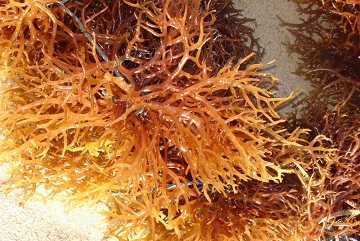IPB Students Utilized Seaweeds as Sunscreen Creams

Seaweed is one of the leading commodities spread in almost all Indonesian waters. Seaweeds contain many bioactive compounds that provides broad-spectrum protection against the harmful effects of UV light. Seaweed is an ingredient in toothpaste, cosmetics and paints, it contains bioactive compounds which can serve as a defense form ultraviolet radiation or sunscreen cream. The study had been implemented by Fevita Maharany, Nurjanah, Ruddy Suwandi of the Department of Aquatic Product Technology, Faculty of Fisheries and Marine Sciences, Bogor Agricultural University (FPIK IPB), Effonora Anwar (University of Indonesia) and Taufik Hidayat (University of Sultan Ageng Tirtayasa). The aim of this study is to apply advanced analytical techniques and kinetic modelling to obtain the chemical composition, phytochemical compounds, vitamin E, and antioxidant activity of extracts Padina australis and Eucheuma cottonii. Seaweeds are classified as red algae (Rhodophyta), blue green algae (Cyanophyceae); brown algae (Phaeophyceae); and green algae (Chlorophyceae). Seaweed used in this study is brown and red seaweed.
Brown seaweed contains phenolic compounds such as florotanin that serves as a defense of ultraviolet radiation (UV). According to previous research, florotanin can capture free radicals caused by UV radiation. Brown seaweed is also known to contain flavonoid compounds. Flavonoids are phenolic compounds that have the greatest chromophore group. The chromophore group led to the ability to absorb UV rays. Types of brown seaweed with the potential to be used is Padina australis.
Seaweed production throughout Indonesia comes from cultivation, Seaweed farming is the practice of cultivating and harvesting seaweed in Java, Bali, NTB, Sulawesi and Maluku. The results stated that E. cottonii seaweed contains proteins, lipids, carbohydrates, tocopherol, minerals, vitamin C, and vitamin E, can synthesize mycosporine compounds (MAAs) that play a role in UV absorption. Sunscreen compounds are usually used to prevent the excessive damage caused by UVB. However, certain photosynthetic organisms have evolved mechanisms to counteract the toxicity of ultraviolet radiation by synthesizing UV screening compounds such as mycosporine-like amino acids (MAAs). MAA represents a family of secondary metabolites that, directly or indirectly, absorb the energy of harmful radiation, protecting the organisms from them
Previous studies revealed that seaweeds are known to contain unique compounds that can find many uses in consumer products. Carrageenans or carrageenins are a family of linear sulfated polysaccharides that are extracted from red edible seaweeds. Carrgageenan produces a medium viscocity, elastic, weak gel and is recemmended for suspensions, lotions and creams.
Minerals commonly found in seaweeds include potassium, sodium, calcium, magnesium, zinc, copper, chloride, sulfur, phosphorous, vanadium, cobalt, manganese, selenium, bromine, iodine, arsenic, iron and fluorine. The chemical composition of P. australis are, moisture content 87.25%; Ash 2.34%; Protein 1.05%; Fat 0.58%; And carbohydrate 8.78%, while the chemical composition E. cottonii are, moisture content of 76.15%; Ash 5.62%; Protein 2.32%; 0.11% fat; And carbohydrates 15.8%. The method used is the yield of P. australis extract using methane solvent 4.55%; 0.8% ethyl acetate and 0.45% n-hexane, while the yield of E. cottonii of methanol solvent was 6.6%; 0.5% ethyl acetate and 0.35% n-hexane.
The results of this study showed that vitamin E content in P. australis 162,75 μg / mL and in E. cottonii 158,07 μg / mL. IC50 in P. australis 87,082 ppm and in E. cottonii 106,021 ppm. Phytochemical compounds contained in P. australis and E. cottonii are flavonoids, hydroquinone phenols, and triterpenoids, P. australis also contains tannins and saponins. The content of these phytochemical compounds indicates that P. australis and E. cottonii are potential to be used as raw materials in the manufacture of sunscreen. (Wied)



